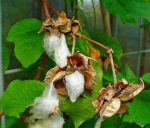 Native to the semi-arid regions of northern Africa, Asia Minor and India, this perennial shrub is a member of the mallow family, Malvaceae, that also includes coffee, okra, and hollyhock. It grows 2-6′ tall and wide, and has wide hairy leaves with 3-7 lobes, heart-shaped bases, and long red-tinged petioles. Flowers 2-2.5″ across appear in summer and have 5 yellow to white petals with purple spots at their base. The flowers give way to globose pods called bolls that burst open in hot weather to expose seeds with 2″ long cotton fibers attached. Plants are not considerered ornamentally valuable but are often grown as annuals for their medicinal, culinary, and fiber potential. The fibers, however, are shorter and more yellow than those of the upland/Mexican cotton (G. hirsutum) which supplies most of the fiber for cloth. Levant cotton is moderately salt tolerant but needs protection from wind. The genus name, Gossypium, comes from the Greek name for the plant, γοσσύπιον. The specific epithet, herbaceum, comes from the Latin word herba meaning grass or herbage, and refers to the soft nature of the stem in contrast to the woody stem of trees and some other shrubs.
Native to the semi-arid regions of northern Africa, Asia Minor and India, this perennial shrub is a member of the mallow family, Malvaceae, that also includes coffee, okra, and hollyhock. It grows 2-6′ tall and wide, and has wide hairy leaves with 3-7 lobes, heart-shaped bases, and long red-tinged petioles. Flowers 2-2.5″ across appear in summer and have 5 yellow to white petals with purple spots at their base. The flowers give way to globose pods called bolls that burst open in hot weather to expose seeds with 2″ long cotton fibers attached. Plants are not considerered ornamentally valuable but are often grown as annuals for their medicinal, culinary, and fiber potential. The fibers, however, are shorter and more yellow than those of the upland/Mexican cotton (G. hirsutum) which supplies most of the fiber for cloth. Levant cotton is moderately salt tolerant but needs protection from wind. The genus name, Gossypium, comes from the Greek name for the plant, γοσσύπιον. The specific epithet, herbaceum, comes from the Latin word herba meaning grass or herbage, and refers to the soft nature of the stem in contrast to the woody stem of trees and some other shrubs.
Type: Perennial shrub
Outstanding Feature: Fibers on seeds
Form: Rounded
Growth Rate: Rapid
Bloom: Summer flowers 2-2.5″ across have 5 yellow to white petals with purple spots at their base.
Size: 2-6′ H x 2-6′ W
Light: Full sun
Soil: Fertile, medium moist, well drained soil in areas with long hot summers with moderate rainfall followed by a drier period for harveting
Hardiness: Zones 9-11
Care: Water during dry spells.
Pests and Diseases: Susceptible to numerous pests and diseases including boll weevils, bollworms, cutworms, armyworms, cotton aphids, whiteflies, thrips, loopers, nematodes, wilts and rots.
Propagation: Seed, cuttings, grafting, budding
Photo Credit: Wikipedia